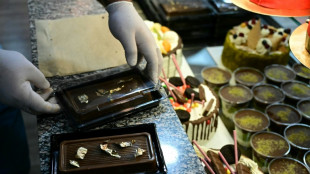

UK ceramist fired up for Elizabeth II's Platinum Jubilee
In his ceramics workshop, Simon Willis proudly displays the crockery set he has created for Queen Elizabeth II's Platinum Jubilee, dreaming it will end up in the monarch's personal collection.
"It's an event which won't ever happen again, we won't have the chance of seeing another queen or king on the throne for 70 years. So it's a big deal," he told AFP.
Willis is the owner of Goviers in Stoke-on-Trent, central England, which has specialised in making commemorative ceramics for more than 30 years.
Elizabeth became queen on February 6, 1952, and June will be the focal point of public celebrations to mark her unprecedented 70-year reign.
To celebrate the occasion, Goviers has been selling a "Platinum Jubilee" range of cups and plates with traditionally English floral designs since last July.
The work is meticulous, with each coloured pattern in the motif individually printed onto a transfer and applied by hand on the fine porcelain cups and plates.
A ceramist brushes the final golden touches to the piece, which is then fired to make it ready for sale.
From the rough cup to the final dabs of paint, everything is made in Stoke-on-Trent, which is also known as The Potteries.
The city has been renowned for its pottery for centuries, taking advantage of local clay for making the ceramics and coal deposits for firing them.
It became the world's centre of pottery production in around 1800, prospering for decades before going into sharp decline, with factories closing and relocating to Asia.
- 'Very English tradition' -
"A lot of the manufacturing has gone abroad," due to cost of production, said the 58-year-old owner.
But those factories don't produce jubilee pieces because "they see the market is not big enough for them", he added.
Willis stumbled into the ceramics industry after studying economics, specialising in the auto industry.
Given most of his customer are collectors from Britain, he had no hesitation in creating a new jubilee line.
"They've probably got plates to celebrate the queen's marriage, or the coronation, all these other events," he said of his clientele.
"They are just a tradition, I suppose, that is very English."
Selling for between £45 ($59, 54 euros) for a small cup and £175 for a large plate, Goviers crockery is not intended to be used as a mere kitchen utensil.
Instead it is meant to be displayed alongside other commemorative ceramics.
"The British ceramics industry has always been good at marking those occasions, big or small," said Willis.
"The great thing about ceramics is that... whatever is produced today, if it's looked after will still be around when my son is probably gone.
"We're producing something that is intrinsically there forever," he added.
- Economic benefits -
Souvenirs dedicated to the popular queen, who turns 96 next month, and the wider royal family are typically rolled out to mark every birth, wedding and celebration.
Such souvenirs generated almost £200 million in revenue during the Diamond Jubilee in 2012, with five million commemorative cups and ceramics sold, according to the UK's Centre for Retail Trade.
Four days of public festivities are planned for early June, including a military parade, a large concert and thousands of street parties around the country.
Despite Brexit and the pandemic, tourists are expected in their droves.
Goviers expects to sell only a few hundred cups and plates, but its boss hopes his tableware will be remembered.
"It is a little bit special doing something that is associated with a royal event, a big event... for an occasion which has been celebrated all over the world," said Willis.
He is particularly keen to impress one potential customer.
"We do know that the queen obviously has a massive collection of ceramics. But a couple of things that we've done, they may well get into the hands of Her Majesty," he added.
A.Jonsson--RTC



